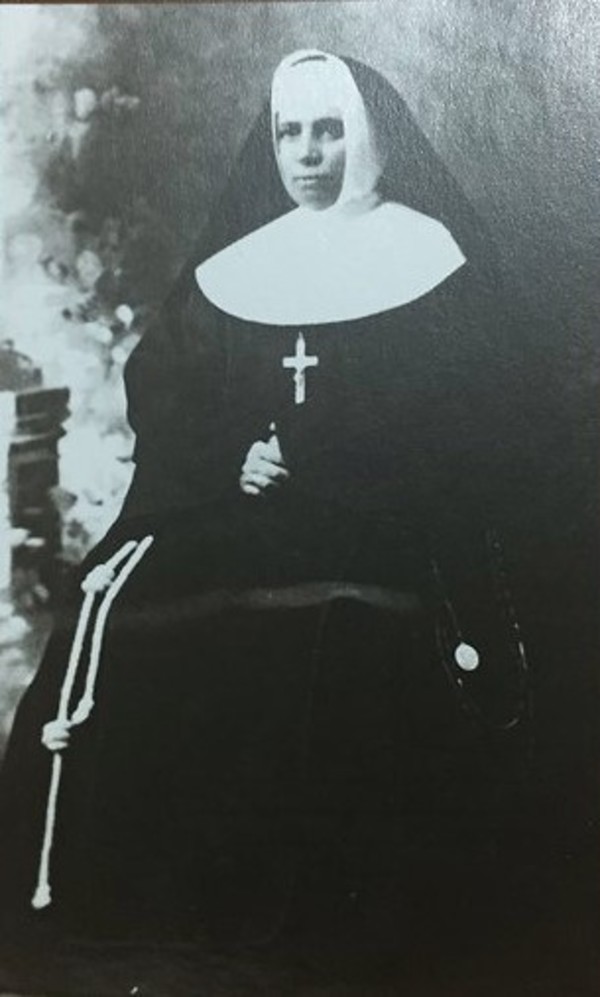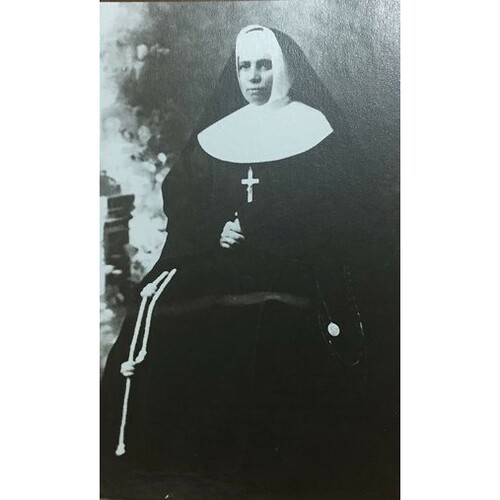
Source: Link
BIBEAU (Bibeault), MARIE (Mary), named Marie-Anne-de-Jésus, first superior general of the Little Franciscans of Mary; b. 9 Oct. 1865 in Sorel, Lower Canada, daughter of Pierre Bibeault, a farmer, and Catherine Latraverse; d. 30 April 1924 in Baie-Saint-Paul, Que.
Marie Bibeau attended the elementary school in her village, where she obtained a basic education, and then worked as a dressmaker. Around 1887 she emigrated to Massachusetts with her family and settled in Manchaug, south of Worcester, where there was a large Franco-American community. The parish priest of Notre-Dame-des-Canadiens in Worcester, Joseph Brouillet, was making arrangements to open an orphanage in a house he had bought. His intention was to found a religious community that would take charge of this charitable work and he persuaded two women teachers, both Third Order Franciscans, and Marie-Louise Rondeau, a student at the convent of the Sisters of the Presentation of Mary in Saint-Hyacinthe, Que., to form its nucleus. The orphanage opened on 13 Aug. 1889. Drawn to the religious life, Marie Bibeau decided to join the group and she was received as a postulant on 7 Oct. 1889. On 24 November she donned the habit and was given the name Marie-Anne-de-Jésus. The community, which was in the Franciscan spiritual tradition, had three novices and two postulants to take care of some 40 children. They had a great deal of work, and daily appeals for funds, making and mending the children’s clothing, and teaching left little time for the religious life.
In the summer of 1890 the sisters had to face the fact that their community was at risk because of decisions made by its founder, who had, moreover, acted without episcopal authorization. Brouillet had accepted too many candidates, they had taken the habit hastily after only rudimentary religious instruction, and the workload had increased substantially following too rapid expansion. In addition, his disagreement with the community’s chaplain, the Oblate Zotique Durocher, about the training of novices, as well as his imprudent financial management, had created serious instability. The “nuns,” who had “no security, either spiritual or temporal,” according to their legal adviser, Ambroise Choquet, took the advice of friends and benefactors and applied for civil recognition under the name of Sœurs Oblates de Saint-François d’Assise on 10 Sept. 1890. They obtained the protection of Bishop Patrick Thomas O’Reilly of Springfield, who informed them, however, that they were not nuns. A lengthy dispute commenced between the Oblate sisters and Brouillet, who spread a rumour that they had been excommunicated and who refused them the sacraments. He even called in a sheriff to evict them from their house in January 1891.
After taking refuge in an abandoned dwelling in Worcester (“the house of misery,” as they called it), the 15 “nuns” opened a new orphanage and tried to resolve their problems. They were put in touch with the parish priest of Baie-Saint-Paul, Ambroise Fafard, who had founded a hospice in his parish in 1889 and was looking for a community to manage it. Sister Marie-Anne-de-Jésus and Sister Marie-Joseph (Marie-Louise Rondeau) went to Baie-Saint-Paul to discuss the project and to meet Bishop Louis-Nazaire Bégin of Chicoutimi. They decided to set a new course for their “community” on 13 Nov. 1891, while retaining their orphanage in Worcester. The “Brown Nuns” had now arrived in Baie-Saint-Paul, but they would have to do their noviciate again, since they were not really nuns. Sister Marie-Anne-de-Jésus was closely involved in the many negotiations connected with this difficult beginning, in her capacity as first superior general, an office to which she was elected in January 1892. She described in a letter “the days strewn with thorns on which [the sisters had been] wounded many times.”
The Hospice Sainte-Anne in Baie-Saint-Paul did, however, force the “Brown Nuns” to rethink their original mission. Fafard had signed an agreement with the Quebec government to accept 50 insane patients in addition to the 20 or so elderly people already in its care. The superior wrote: “Our idiots are giving us a great deal of trouble.” She worked alongside her sisters, and, in her outspoken way, referred to herself as a “stopgap.” She organized appeals in the countryside. “We pick up everything: hens, geese, turkeys, sheep, all in the same wagon,” she explained. Every year she returned to her home parish to raise funds, an activity at which she was reputed to be effective. As well, she welcomed the Franciscan Missionaries of Mary, who came from France in May 1892, seeking to integrate the 11 “founding women” into their congregation. When this merger failed (the constitutions of the French community were not consistent with the charitable work being undertaken), Mother Marie-Anne-de-Jésus had the satisfaction of obtaining, on 7 June 1892, authorization from the diocese to establish the Little Franciscans of Mary and open a noviciate. In 1902 she would ask Franciscan Berchmans-Marie Mangin to help draw up the fledgling congregation’s constitutions and provide a Franciscan education for the nuns.
It proved difficult, however, to carry on the charitable work in Worcester. The superior general met with Bishop Bégin of Chicoutimi and his successor, Michel-Thomas Labrecque, as well as with Bishop Thomas Daniel Beaven of Springfield and the apostolic delegate to Washington, Mgr Sebastianni Martinelli, to settle the matter. Abbé Brouillet, “who likes to create a brouhaha,” as Labrecque put it, continued to make slanderous comments and tried in every way to prevent the young community from keeping its orphanage in Worcester. The nuns could, however, count on the support of their first chaplain, Father Durocher, of their confessor, the Jesuit Darveni-Hugues Langlois, and of Abbé Fafard. The issue dragged on and was not settled until 7 Dec. 1897. Bishop Beaven accepted the nuns into his diocese, but they would have to turn their orphanage into a home for the elderly, since the Sisters of Charity of the Hôpital Général of Montreal were already taking care of orphans in Worcester.
After the death of Fafard on 12 Aug. 1899, Mother Marie-Anne-de-Jésus showed the strength of her personality. It was she who completed the extensive projects begun by the founder of the hospice. Taking charge of the construction required by the expansion of the work with the insane, she also undertook the building of the mother house in Baie-Saint-Paul, and negotiated a series of contracts with the government. She managed the community’s farm and the electrical company that serviced the hospice, its outbuildings, and the village. As well, she directed the organization of fund-raising appeals and celebrations and the improvement in services to the mentally ill, and she planned the expansion of the community, including the opening of five schools in New England. Her keen intelligence, administrative skill, and bold faith won her the admiration of religious and lay leaders alike. In 1908 the Hospice Sainte-Anne was home to 105 patients (epileptics, idiots, and those “lacking human feelings”), 39 elderly persons, 20 private boarders, and 79 nuns. Of the more than 100 people in the community, only six were laity, and the nuns were regularly called on for such heavy labour as piling bricks, repairing mortar, painting walls and porches, digging potatoes, and crushing flax.
In 1908 Mother Marie-Anne-de-Jésus asked to be relieved of her responsibilities as superior general because of failing health. From then on she played a much less visible role. Her talents as a healer, her marvellous recipes for sweets, and her compassion for her parishioners were highly praised. In 1920 she accepted the office of procurator general (or bursar), which she relinquished in 1923 for reasons of health. She died on 30 April 1924; her last words, according to the superior general, Marie-Claire-d’Assise, were: “I see absolutely nothing in my life that can be considered a work of charity.”
For nearly 20 years, however, Mother Marie-Anne-de-Jésus had found her life taken up by the difficult task of managing a Franciscan community. Working with the American founder, Mother Marie-Joseph, as her chief associate in this venture, she was the Canadian founder and carried out the most difficult negotiations.
ANQ-M, CE603-S7, 10 oct. 1865. Arch. des Petites Franciscaines de Marie (Baie-Saint-Paul, Qué.), Album-souvenir des noces d’argent de l’hospice Sainte-Anne; Annales de la fondation de la communauté; Dossier personnel de mère Marie-Anne-de-Jésus. Michelle Garceau, Par ce signe tu vivras: histoire de la congrégation des Petites Franciscaines de Marie (1889–1955) (4e éd., Baie-Saint-Paul, 1989). Marguerite Jean, Évolution des communautés religieuses de femmes au Canada de 1639 à nos jours (Montréal, 1977), 121–24. Petites Franciscaines de Marie, Notice sur l’Institut des Petites Franciscaines de Marie (Baie-Saint-Paul, 1916; 2e éd., 1927). Margaret Porter, Mille en moins: histoire du centre hospitalier de Charlevoix (1889–1980) (Baie-Saint-Paul, 1984).
Cite This Article
Micheline Dumont, “BIBEAU (Bibeault), MARIE (Mary), named Marie-Anne-de-Jésus,” in Dictionary of Canadian Biography, vol. 15, University of Toronto/Université Laval, 2003–, accessed April 1, 2025, https://www.biographi.ca/en/bio/bibeau_marie_15E.html.
The citation above shows the format for footnotes and endnotes according to the Chicago manual of style (16th edition). Information to be used in other citation formats:
| Permalink: | https://www.biographi.ca/en/bio/bibeau_marie_15E.html |
| Author of Article: | Micheline Dumont |
| Title of Article: | BIBEAU (Bibeault), MARIE (Mary), named Marie-Anne-de-Jésus |
| Publication Name: | Dictionary of Canadian Biography, vol. 15 |
| Publisher: | University of Toronto/Université Laval |
| Year of revision: | 2005 |
| Access Date: | April 1, 2025 |



